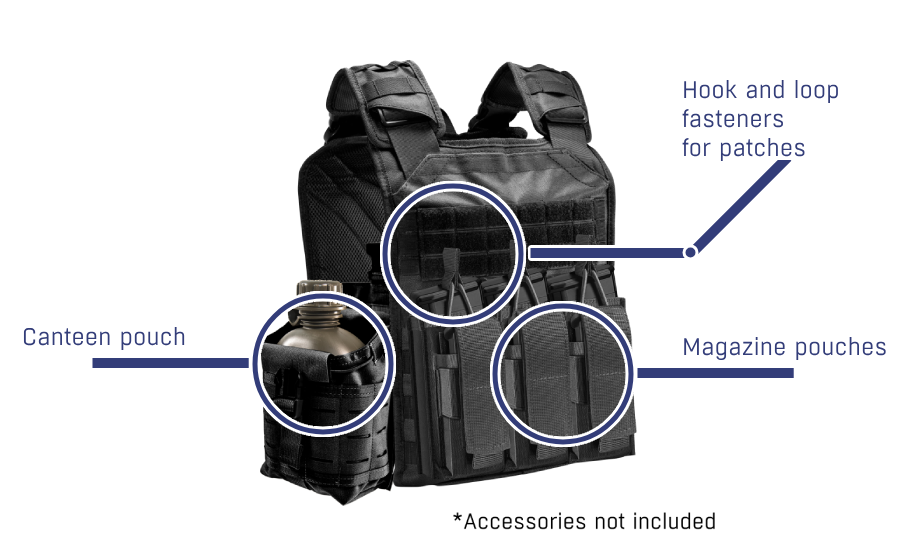The versatility of MOLLE webbing allows those who wear plate carriers to put on a wide variety of attachments, allowing quick access to tools without having to fumble around looking for items in rucksacks, waist bags, or fanny packs. Tactical accessories include items ranging from essential to situational, and great care should be taken to ensure they are easy to reach.
Mag pouches: used for storing your magazines. A good number of these should be kept on your plate carrier, as they will be essential in a firefight. However, keep in mind the old military adage that “pounds equal pain” and that an excessive number of magazines in an normally peaceful environment such as a shopping center in the wealthy part of town will be both unnecessary and bad for your back. However, carrying 12 magazines while pulling security for an international company operating in a middle eastern hotspot may be necessary, since engaging a large number of enemy combatants is a realistic possibility.
Drop pouches: Used to catch empty magazines during tactical reloads, a drop pouch is a range accessory. There is no need to wear one on duty, since the precious seconds spent carefully tossing your empty magazine into your drop pouch can instead be spent engaging a threat. When performing tactical reloads in the real world, just drop your magazine. There’s a man trying to kill you on the other side, and he would like it very much if you turned your attention away from him just to toss away your empty mag for cleanliness’s sake.
IFAK: Your individual first aid kit is a necessity, whether your kit is for security, law enforcement, or private contract work. The first aid kit should contain essentials such as bandages, disinfectant, cotton balls, scissors, and a tourniquet; essentially everything needed to stop the bleeding from a gunshot wound. The first aid kit is not a field surgeon’s bag, you are not a medic. It is meant to stop you or one other person from bleeding out. It does not necessarily need to have aspirin for headaches or tums for an upset stomach. The IFAK should be easily accessible and should not require the wearer to contort his or her arm in a position that would be impossible for an injured individual to pull off.
Radio: Your radio should be easily accessible in such a way that you’d be able to queue it with one hand. Usually placed on the shoulder strap of your vest, it would be a bad idea to place your radio on your hop or any other body part that moves while you’re moving.
Multitool: An optional, but sometimes necessary accessory. You’ll never know when you’ll need a screwdriver to tighten a loose bolt on your weapon or a knife to cut off the excess tail of a zip tie. The modern multitool also has scissors for cutting bandages, pliers for utility work, and a bottle opener. Try not to go anywhere without a knife of some sort. You’ll never know when you might need it.
Hydration: This is a must. If you’re spending any good amount of time in the outdoors wearing what is essentially a weighted vest, a canteen pouch on your vest or a CamelBak on the back would be a great option. While many hydration packs come with backpack-type straps, some are outfitted with MOLLE webbing to be attached to the backs of a MOLLE-compatible tactical vest.
Flashlight: If you work security, you might be required to patrol dark parking lots or dimly lit alleys. Flashlights are also needed for peering into corners or under vehicles. It’s also useful for signaling others and can work as a nonlethal self-defense tool in a pinch. A modern tactical flashlight is small enough to conceal in its own pocket or secured by a clip on a MOLLE strap.
Pen and paper: Note-taking is essential when working any job that requires you to have attention to detail. Working a job that requires you to be out in the field with a rifle and armor is no exception. Police officers may need to jot down details of a crime as well as potential witnesses and suspects. License plates of offending vehicles and street maps may also need to be noted.
Armor plates: Your tactical vest is little more than a front-facing backpack if it isn’t packed with armored plates. BulletSafe offers lightweight IIIA bulletproof panels for stopping pistol rounds up to .44 magnum as well as rigid, heavy duty Level IV plates capable of defeating rifle fire up to .30-06 AP. Regardless of which you choose, know that BulletSafe’s materials are NIJ certified, guaranteeing high quality protection.

